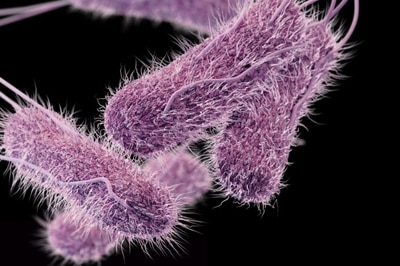AMD Projects: Sequencing Foodborne Bugs
Transforming public health microbiology with whole genome sequencing for foodborne diseases

Salmonella causes approximately 1.2 million illnesses in the United States each year.
Bacteria such as Salmonella, Shiga toxin-producing Escherichia coli (STEC), and Listeria monocytogenes are among the bugs that cause the most outbreaks and severe illness from food. In order to understand the occurrence of foodborne diseases, the bugs are routinely identified, and scientists monitor their ability to cause disease (virulence) and antimicrobial resistance. During outbreaks, these bacteria must also be subtyped and compared in real time to identify clusters of infected patients that are likely to be infected from the same source.
PulseNet is an integrated network of over 85 U.S. public health, regulatory, and agriculture laboratories that uses a standardized DNA “fingerprinting” subtyping method on disease-causing bacteria obtained from sick patients, food, animals, and the environment. Using common tools and uploading data onto state and national databases, it is possible to match cases of illness, detect outbreaks, and identify sources of contamination. The methods currently used to identify, characterize and subtype foodborne bacteria are unique to each bug and require many time-consuming steps. Building on experience from an ongoing listeriosis project, CDC will consolidate most foodborne pathogen identification and characterization activities to a single, fast, and efficient whole genome sequencing process. Scientists also will create a standardized, national database and analysis platform.
This project will enhance significantly the ability of CDC and its state and local partners to determine what types of foods and activities make people ill from foodborne diseases. This information will provide more reliable information about the bugs that cause most illness associated with food and increase the ability of CDC, industry, and regulatory agencies to identify and stop outbreaks when they are small. This information will further increase the safety of the United States and the global food supply.
2017 Project Update
During the first three years of this project, CDC has begun improving foodborne pathogen identification and characterization activities by upgrading to a single, fast, and efficient whole genome sequencing (WGS) process for the most common foodborne pathogens — Listeria, Campylobacter, Shiga toxin-producing Escherichia coli (STEC), Salmonella, Vibrio, and Shigella. Yersinia and Cronobacter will follow in 2017. Building on the existing PulseNet infrastructure, database, and software already familiar to the laboratories in the network, CDC has created a system to store WGS information in a national repository for scientific analysis. CDC is currently validating the WGS process against standards that apply to all clinical laboratory testing with the goal of replacing most foodborne reference, or traditional microbiology testing, activities with WGS at CDC and state laboratories. Currently, 33 laboratories in 30 states have been trained and submit WGS data to PulseNet, with data being analyzed centrally at CDC. The plan is for public health laboratories in all 50 states to have PulseNet sequencing capacity by the end of 2017. In 2017 and 2018, project investigators will make the sequence data analysis capacity available to public health laboratories, so that PulseNet will be a fully WGS-based real-time system by the end of 2018.






















.png)











No hay comentarios:
Publicar un comentario